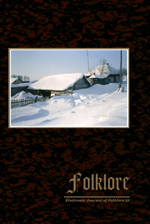The Funeral Culture of Estonians in the Minusinsk Region, Siberia, as a Representation of the Community and Its Transformation
The Funeral Culture of Estonians in the Minusinsk Region, Siberia, as a Representation of the Community and Its Transformation
Author(s): Anu KorbSubject(s): Customs / Folklore
Published by: Eesti Kirjandusmuuseum
Keywords: community; death and funerary culture; Estonians; identity; multiculturalism; Siberia
Summary/Abstract: The article discusses the death and funeral culture of Estonians inhabiting the Minusinsk region in East Siberia as a representation of the community’s solidarity and a sense of belonging, while observing changes in the funeral culture. The majority of Estonians living today in the Minusinsk region are descendants of the peasants who migrated to this area in search of free land in the last quarter of the 19th and at the beginning of the 20th centuries, or were deported from Estonia or forced to settle in Siberia after had been passed the tsar’s law in 1845, according to which the region was defined as the Lutheran settlement in East Siberia. Most of the Estonians who later migrated from urbanised villages to towns remained closely connected with their home village and therefore considered themselves as part of the Estonian community. The funeral culture of Estonians in Siberia is inseparably connected with the Lutheran liturgical tradition and the Estonian language. Regardless of abrupt political changes (the Bolsheviks’ return to power, banning of all religious activities, repressions, wars, etc.), religious funerals have survived as part of the tradition. Funeral rituals are officiated by village buriers, who have to pay notice to other community members. The most direct function of such collective ritual practices is to unite the community. The community’s funeral practices clearly reflect group identity, attempts to observe ancestral customs, emphasising the importance of helping each other in the community. Along with changes in society, times of crisis, political situation, the influence of multicultural environment, the growing number of mixed marriages, etc., the funerary tradition is also undergoing a transformation.
Journal: Folklore: Electronic Journal of Folklore
- Issue Year: 2014
- Issue No: 58
- Page Range: 127-148
- Page Count: 22
- Language: English

